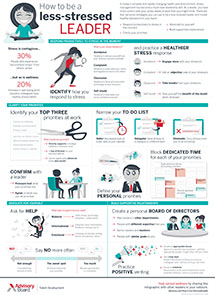Auto logout in seconds.
Continue LogoutRead Advisory Board's take: How to reduce your stress at work
Stress is a normal part of most jobs, and it's not uncommon for work-related pressures and responsibilities to seep into one's home life, Sabina Nawaz, a global CEO coach, writes in Harvard Business Review. Nawaz outlines five ways to prevent stress from work from interfering with life at home.
New job, new stress—and its toll at home
To explain how work-related stresses and seep into one's home life, Nawaz shares the story of a new CEO in charge of a $1 billion company, whom she calls Firaz.
According to Nawaz, Firaz was feeling "overwhelmed" by his new commitments and position of authority, and he "wasn't feeling successful at home either."
While he maintained his promise to be home for family dinners, he was only there physically. Firaz's "mental attention was captured by a new [work] text pinging every few minutes," Nawaz writes. He often fell asleep when he shouldn't and was awake at odd hours when he should've be asleep.
5 ways to stop work stress from coming home with you
Firaz's experience, Nawaz writes, is not unique to CEOs. "Stress is a part of most jobs," Nawaz notes, but there are ways to keep it from taking over your personal life. Using Firaz's success in setting boundaries between work and home as an example, Nawaz shares five ways to make sure your work stress doesn't come home with you.
- Communicate with your family. If you're not mentally present at home, your family may think they did something wrong, or that you don't value them, Nawaz writes. To keep that from happening, communicate clearly with them about the extent of your work obligations. Firaz learned to tell his family, "I'm learning my new role, and it's a big step up. I'm feeling overwhelmed and you might see me taking work calls more often than I'd like to for the next three months," Nawaz writes. This helped Firaz share is burden and avoid bottling up his stress, which could lead to an outburst at work or at home, Nawaz notes.
- Transition from work to home. As you commute home from work, take the time to transition between the two places, Nawaz writes. Firaz, for example, would stop at a lake on his way home sit on a bench, and look at the view for two minutes before getting back in the car. This would help him shut down his work issues and prepare for the interactions he'd have at home, Nawaz writes.
- Find someone to talk to. While it's helpful to share with your family what's on your mind, "be sure not to unload all your pent-up emotions on them," Nawaz writes. Instead, find a friend or colleague you can talk to and vent or ask for advice.
- Set aside a family day and a work day. Pick a day when you'll be home and entirely present for your family and then pick a day when you might come home later from work than usual, Nawaz writes. On your work day, you can plan for evening work engagements or to spend time tackling your to-do list. Making these days consistent allows for your family to plan in advance, Nawaz writes.
- Be thankful. Research shows gratitude can help reduce stress, Nawaz writes. Before you get home, think about your day and pick one thing you're grateful for. For Firaz, even on difficult days, he could at least be grateful for the Starbucks on the first floor of his building, Nawaz writes.
"By proactively managing your stress, you loosen the grip stress has on you and regain control of job and life," Nawaz concludes (Nawaz, Harvard Business Review, 3/26).
Advisory Board's take

Kate Vonderhaar, Practice Manager, HR Advancement Center
It's definitely a worthy aspiration to leave your work stress at work. But it's also worth going a step further to ask: How can you reduce the amount of negative work stress you experience in the first place?
Register now: How to Get More Done (With Less Stress)
We've looked into the question many times in our research and found one deceptively simple strategy: clarifying your priorities. Research shows that many of us spend as much as 40% of our work time on tasks that are either low-value or that others could do. These tasks consume so much of our time that they can leave us rushing—and stressed—when finishing the remaining 60%.
So how can you identify and weed out these unnecessary tasks? You have to be smart about what to prioritize. Your priorities should include work that directly supports a strategic initiative or business need; is top-of-license for your level and skillset; and can be meaningfully advanced in the next month. Aim to focus on three priorities each month.
“Double-check your priorities with your manager—and explicitly discuss what you won't focus on”
Once you've identified your top three priorities for the month, double-check that your manager agrees with them—and explicitly discuss what you won't focus on. Other work still has to get done, of course—but your goal will be to delegate as many of these tasks as possible or defer them (rescheduling to a later date on your calendar), so you can focus on these top three priorities.
Now, of course, identifying the right set of priorities to focus on is arguably the easy part. Defending those priorities against the slew of incoming requests and potential new priorities can be much harder. That's why another key skill for managing work stress is knowing when and how to say "no."
Most of us fall somewhere along a "no" spectrum. At one extreme, some people say no to every "extra" request that comes their way. Eventually, people stop asking for their help and they miss out on opportunities to contribute their expertise and experience. Far more health care leaders fall toward the other extreme: saying "yes" to every request. If this is your default operating mode, people will likely begin over-relying on your help—and you won't have time for your most important priorities. If you can strike the right balance between always saying no and never saying no, people will ask for your help—but they won't know for sure if you'll be able to offer it. They'll know you'll want to help them if you can, but you'll have to weigh the request against your other priorities.
Ultimately, no matter which side of this spectrum you fall on, saying no is a skill like any other—it takes regular practice to improve! And we can help. Join us for out webconference on April 23rd at 1 pm ET to discover our foolproof method for weeding out unnecessary tasks and learn tried-and-true tips for how to clearly state your case for saying no and prepare for pushback.
Don't miss out on the latest Advisory Board insights
Create your free account to access 1 resource, including the latest research and webinars.
Want access without creating an account?
You have 1 free members-only resource remaining this month.
1 free members-only resources remaining
1 free members-only resources remaining
You've reached your limit of free insights
Become a member to access all of Advisory Board's resources, events, and experts
Never miss out on the latest innovative health care content tailored to you.
Benefits include:
You've reached your limit of free insights
Become a member to access all of Advisory Board's resources, events, and experts
Never miss out on the latest innovative health care content tailored to you.
Benefits include:
This content is available through your Curated Research partnership with Advisory Board. Click on ‘view this resource’ to read the full piece
Email ask@advisory.com to learn more
Click on ‘Become a Member’ to learn about the benefits of a Full-Access partnership with Advisory Board
Never miss out on the latest innovative health care content tailored to you.
Benefits Include:
This is for members only. Learn more.
Click on ‘Become a Member’ to learn about the benefits of a Full-Access partnership with Advisory Board
Never miss out on the latest innovative health care content tailored to you.

